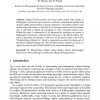Free Online Productivity Tools
i2Speak
i2Symbol
i2OCR
iTex2Img
iWeb2Print
iWeb2Shot
i2Type
iPdf2Split
iPdf2Merge
i2Bopomofo
i2Arabic
i2Style
i2Image
i2PDF
iLatex2Rtf
Sci2ools
EUROMED
2010
2010
A Simple Approach to Link 3D Photorealistic Models with Content of Bibliographic Repositories
Linking 3D photorealistic and virtual reality models with contents of bibliographic repositories and resources is needed for archeological and historical analyses, public understanding of ancient settlements, and simple common sense studies using web content. As the Web 2.0 is used more and more by the community, it will help to deepen the knowledge of many interested internet users. Within this paper, a combination of 3D photorealistic modeling and content of bibliographic repositories, which describes the history of the Hirsau Abbey, Germany, is presented. In particular, it will serve for the special needs of the Verein "Freunde Kloster Hirsau e.V." which is a registered association for taking care of the Hirsau Cultural Heritage site. The 3D photorealistic models have been acquired by means of static LiDAR and HD close range photogrammetry.
Bibliographic Repositories | Electronic Publishing | EUROMED 2010 | Photorealistic | Virtual Reality Models |
| Added | 11 Feb 2011 |
| Updated | 11 Feb 2011 |
| Type | Journal |
| Year | 2010 |
| Where | EUROMED |
| Authors | Wassim Moussa, Dieter Fritsch |
Comments (0)

